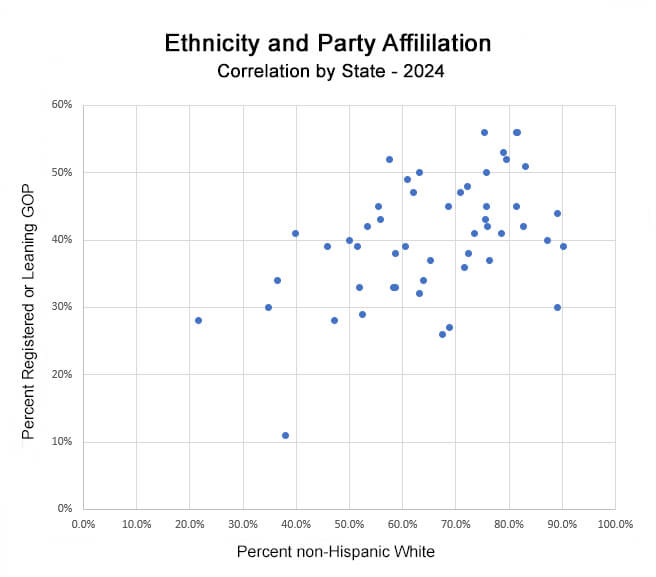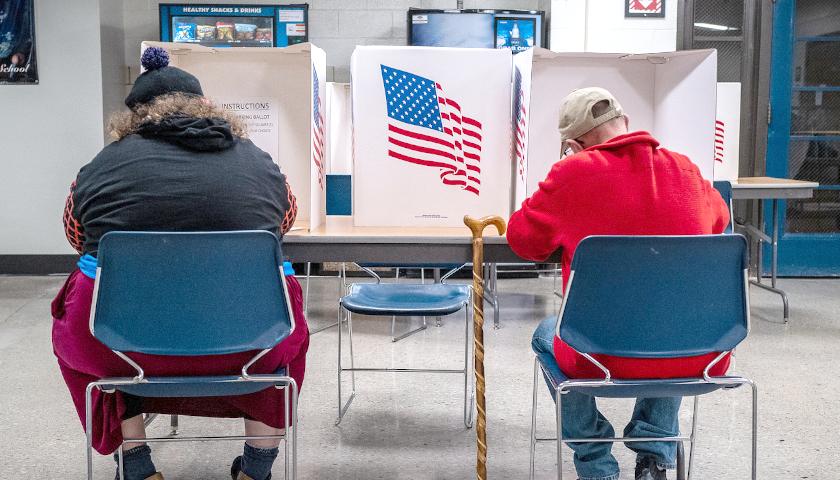by Edward Ring
It has become a truism among right-of-center voters in America that as the percentage of non-Hispanic whites in the population decreases, the percentage of registered Democrats increases. This truism is shared, of course, by the progressive left in America. That might lead one to conclude that if Democrats wanted to turn America into a one-party nation, they would do everything in their power to increase the percentage of voters who are not “non-Hispanic whites.”
There is evidence to support this truism. For example, in 1970, the population of California was 80 percent non-Hispanic whites, with Republican governor Ronald Reagan and both houses of the state legislature controlled by Republicans. That was the last year Republicans had a trifecta in the state. Today, California’s population of non-Hispanic whites has declined to 34 percent, and the state is under the absolute control of Democrats. They have held both houses of the state legislature since 1997, and apart from Schwarzenegger’s anomalous presence from 2004 through 2010, the state hasn’t had a Republican governor since 1998.
Bearing in mind that correlation is not necessarily causation, here’s a nationwide look at the correlation between the percentage of non-Hispanic whites and the percentage of “GOP-leaning” voters. Using data from the US Census Bureau and Gallup, the scatter diagram below depicts party preference on the vertical axis and the non-Hispanic white population on the horizontal axis. You don’t have to perform a regression analysis to see a strong correlation. Generally speaking, the higher the percentage of whites in any US state, the higher the percentage of GOP voters, and the lower that percentage of whites, the lower the percentage of GOP voters.

Just as correlation may not equate to causation, actions may not be motivated by certain truisms. But with another American presidential election just a few months away, it may be productive to speculate as to what might constitute additional, much deeper motivations. It’s not enough to claim Democrats want to import millions of non-white voters at the same time as Democrats relentlessly demonize white Republicans as racist bigots living on stolen land. That’s all true, and it attracts votes for Democrats, but it is surface phenomena.
Democrats are part of a uniparty that used to include a majority of Republican politicians. Up until 2016, most Americans accepted what was always a false illusion of a competitive two-party system. To be sure, there was debate around the edges of policy. However, there was a consensus that embraced mass immigration for reasons that were purely pragmatic and economic.
Government agencies at all levels welcomed the new programs that would have to be funded to assist new immigrants. Private businesses welcomed the influx of workers willing to accept low wages. Investors welcomed the inevitable shortages—abetted by the useful idiocy of environmentalist extremists—which drove up the value of their portfolio assets. In general, as our population grows, government grows, the economy grows, and monopolies grow. Most of this growth, however, has harmed the middle class. It has also denied upward mobility to America’s low-income communities and youth.
But beginning in 2016, the illusion of competition between the traditional parties has been shattered, and over the past eight years, the Republican party has systematically purged its RINOs. As a result, for the first time in modern history, Americans have a choice this November. It is a choice that has growing support from non-whites.
Democrats today are comprised of two very distinct groups. At the top, there are donors and constituents who are white liberals who are either affluent enough to be exempt from the economic challenges that most Americans face today, or they are actively profiting from it. At the bottom are millions of Americans who have become dependent on government aid to survive. But will America’s non-whites continue to believe that their poverty is caused by Republican racists, and that only by voting for Democrats can they hope to survive economically?
According to voting data over the past few elections, this narrative is wearing thin. In 2012, the Latino vote for uniparty stooge Mitt Romney was 27 percent. In 2016, Trump increased that to 29 percent, and in 2020, Trump got 32 percent from Latinos. After surging earlier this year, the Kamala Harris candidacy has allegedly derailed Trump’s momentum with Latinos, but even so, as of August 5, Trump’s support in battleground states among Latinos was up to 37 percent. Some polls earlier this year had Trump ahead of Biden among Latinos.
Even the almost universal support for Democrats among blacks has been eroding. Romney attracted a dismal 6 percent of the black vote in 2012, and Trump increased that to 8 percent in 2016. But by 2020, Trump increased his share of the black vote to 12 percent. As for this election, until Kamala Harris replaced Biden as the Democratic nominee, polling was consistently estimating that Trump’s support among black voters had risen to 23 percent.
Asian voters are also defecting, and some indicators suggest by a lot over the last few elections. Exit polling in 2016 had Asian support for Trump at 18 percent, whereas in 2020, that had risen to 31 percent. A July 2024 poll reported Asian voter support for Trump holding at 31 percent, although that was before Harris replaced Biden as the Democratic candidate.
Overall, recent decades of data on voter behavior confirm that non-whites overwhelmingly support Democrats, but the data also shows that support dropping every election cycle. More to the point is that since 2016, something fundamental has changed. Republicans in 2024 are a fully transformed party, capable of offering a genuine choice. RINOs are now the exception, not the rule.
This time, non-white voters, along with their non-Hispanic white counterparts, will have an opportunity to decide between two visions of the future. If they vote Republican, they are supporting merit-based, controlled immigration. They are supporting a crackdown on environmentalist extremism, along with an all-of-the-above energy strategy that will lower the cost of living. They are supporting law and order, including cracking down on fentanyl dealers and declaring war on drug cartels. They are supporting deregulation to enable businesses large and small to flourish, creating millions of jobs. And they are supporting peace in the world.
Or they can support a pair of race and gender-baiting career demagogues, who will do none of the above.
If Republicans can convey this new reality, that they are the party of peace and prosperity, and Democrats are the party of endless war and an economy rigged to benefit bureaucrats and billionaires, they will break the cycle. What Democrats offer Americans this year is not a future anyone should want, regardless of their origins.
Demographic trends in America may indeed trigger a realignment, but it may not be the one that Democrats have long taken for granted.
– – –
Edward Ring is a senior fellow of the Center for American Greatness. He is also the director of water and energy policy for the California Policy Center, which he co-founded in 2013 and served as its first president. Ring is the author of Fixing California: Abundance, Pragmatism, Optimism (2021) and The Abundance Choice: Our Fight for More Water in California (2022).
Photo “Voters Casting Ballots” by Phil Roeder.





